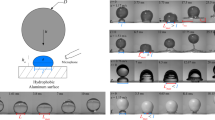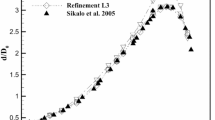Abstract
When a liquid drop lands on a solid surface without wetting it, it bounces with remarkable elasticity1,2,3. Here we measure how long the drop remains in contact with the solid during the shock, a problem that was considered by Hertz4 for a bouncing ball. Our findings could help to quantify the efficiency of water-repellent surfaces (super-hydrophobic solids5) and to improve water-cooling of hot solids, which is limited by the rebounding of drops6 as well as by temperature effects.
This is a preview of subscription content, access via your institution
Access options
Subscribe to this journal
Receive 51 print issues and online access
$199.00 per year
only $3.90 per issue
Buy this article
- Purchase on SpringerLink
- Instant access to full article PDF
Prices may be subject to local taxes which are calculated during checkout


Similar content being viewed by others
References
Hartley, G. S. & Brunskill, R. T. in Surface Phenomena in Chemistry and Biology (ed. Danielli, J. F.) 214 (Pergamon, Oxford, 1958).
Richard, D. & Quéré, D. Europhys. Lett. 50, 769–775 (2000).
Aussillous, P. & Quéré, D. Nature 411, 924–927 (2001).
Hertz, H. J. Reine Angew. Math. 92, 156–171 (1881).
Nakajima, A., Hashimoto, K. & Watanabe, T. Monatshefte Chim. 132, 31–41 (2001).
Frohn, A. & Roth, R. Dynamics of Droplets (Springer, Berlin, 2000).
Landau, L. D. & Lifschitz, E. M. Theory of Elasticity 3rd edn (Pergamon, Oxford, 1986).
Rayleigh, Lord Proc. R. Soc. Lond. A 29, 71–97 (1879).
Wachters, L. H. J. & Westerling, N. A. J. Chem. Eng. Sci. 21, 1047–1056 (1966).
Perez, M. et al. Europhys Lett. 47, 189–195 (1999).
Author information
Authors and Affiliations
Corresponding author
Ethics declarations
Competing interests
The authors declare no competing financial interests.
Rights and permissions
About this article
Cite this article
Richard, D., Clanet, C. & Quéré, D. Contact time of a bouncing drop. Nature 417, 811 (2002). https://doi.org/10.1038/417811a
Issue Date:
DOI: https://doi.org/10.1038/417811a
This article is cited by
-
An energy-free strategy to elevate anti-icing performance of superhydrophobic materials through interfacial airflow manipulation
Nature Communications (2024)
-
Droplet impact on doubly re-entrant structures
Scientific Reports (2024)
-
Unraveling the role of vaporization momentum in self-jumping dynamics of freezing supercooled droplets at reduced pressures
Nature Communications (2024)
-
Experimental study on the impact behaviors of a water drop on immiscible oil surfaces: bouncing, compound central jet formation and crater evolution
Experiments in Fluids (2024)
-
Numerical investigation of spreading time in droplet impact with a large spherical surface: from physical analysis to data-driven prediction model
Theoretical and Computational Fluid Dynamics (2024)



